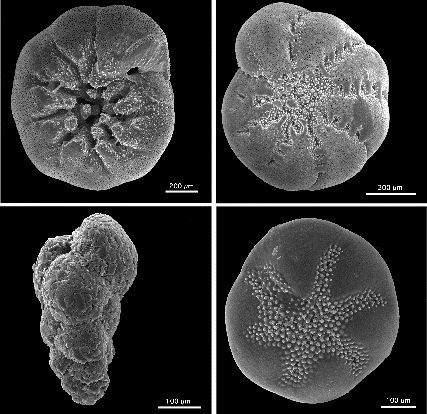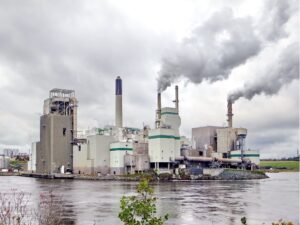
Figure 1: Four benthic foraminifera photographed by a Scanning Electron Microscope
Source: Wikimedia Commons
Did you know time travel exists? All you need is a microscope and some foraminifera! Foraminifera are a type of single-celled protist; their shells, also known as tests, are composed of chemicals in the surrounding environment. Calcium carbonate (CaCO3) and inorganic compounds found within these tests make foraminifera useful as environmental and historical proxies (Katz, 2010). Such a proxy provides an indirect measurement to study past and present climate conditions. Furthermore, the abundance and environmental sensitivity of foraminifera make them useful for conservation assessments.
Water quality evaluations typically require intensive field work and quantitative and qualitative data analysis. However, using foraminifera as a bioindicator can simplify the process. The Foraminifera in Reef Assessment and Monitoring Index (FoRAM Index) was created as an efficient, cost-effective, and long-term water assessment tool for northwest Atlantic and Caribbean reef ecosystems (Hallock, 2003). The success of this index has led to several sites around the world utilizing FoRAM for their own water quality endeavors.
However, transferring a reef environment calculation to a non-reef environment creates unclear data. The FoRAM Index calculation was specifically created for reef ecosystems in the Atlantic and Caribbean. While this does not pose a problem for organizations comparing data to their own index calculations, comparing these calculations between different locations leads to uncertainties in data accuracy (Prazeres, 2020).
A recent study aimed to standardize FoRAM and provide a more accessible index for those wishing to use this metric for ecosystem evaluations. A simple methodology was devised for determining whether the sediment samples procured are suitable for a FoRAM Index calculation. The researchers propose that all samples be standardized for appropriate water depth, number of samples obtained, grain size, and foraminiferal abundance per sample (Prazeres, 2020). This standardization allows for oceanic managers to test if FoRAM is the right index for their particular site while also providing a more accurate sample calculation.
Understanding how water quality is changing over time will provide insight into ecological and oceanic responses to climate change. Anthropogenic degradation, such as agricultural runoff and climate change, have warmed oceans to the point of coral bleaching and decline (Prazeres, 2020). The utilization of diverse and abundant bioindicators, such as foraminifera, is essential for water security and ecosystem remediation. Having a standardized protocol for water quality that is easy, affordable, and accessible will provide many organizations the ability to not only test their own water health, but to compare their results with others using the same metric.
References
Hallock, P., et al. (2003). Foraminifera as Bioindicators in Coral Reef Assessment and Monitoring: The Foram Index. Environmental Monitoring and Assessment, Vol. 81 (1-3), 221-238. doi: 10.1007/978-94-017-0299-7_20.
Katz, M. E., et al. (2010). Traditional And Emerging Geochemical Proxies in Foraminifera. The Journal of Foraminiferal Research, Vol. 40 (2), pp. 165-192. doi:10.2113/gsjfr.40.2.165.
Prazeres, M., et al. (2020). Foraminifera as Bioindicators of Water Quality: The FoRAM Index Revisited.” Environmental Pollution, vol. 257, doi:10.1016/j.envpol.2019.113612.
Related Posts
The Scientists Are Saving the Earth by Turning Greenhouse Gases into Solids
Figure 1: Industries that burn fossil fuels to produce energy...
Read MoreContradicting the Disparity Between Primate and Avian Brains
Figure 1: A Northwestern Crow near Whittier, Alaska. Corvids, along...
Read MoreEven When Out of Production, Oil and Gas Wells Wreak Havoc
Figure 1: An oil pumpjack at dusk Source: Pxhere In...
Read MoreKatherine Faulkner




Comments are closed.